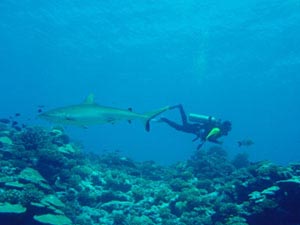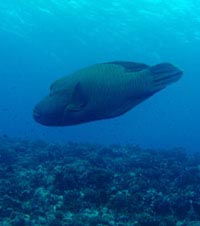17th May - 21st May, 2004

29°C
There were signs of bleaching both inside the lagoon and on the outer reef slopes.
There were no visible signs of disease.
The visibility inside the lagoon ranged from only a few meters to about 10 meters but turbidity was always high. Outside, visibility depended on whether the currents were running into or out of the lagoon, but in general was about 20 meters.
None observed.
Rangiroa is the second largest atoll in the world, making a 48 mile circlet of coral islands which the Polynesians call 'motus'.
During the period of coral reef study, the RV Heraclitus was anchored on the south west side of Avatoru Pass, inside the lagoon. There is a small 'pension' here, plus an interesting 'lagoonarium' where seven nurse sharks and two white tip reef sharks are held in a reasonably sized swimming pen among coral heads, a turtle and many types of reef fish. The village of Avatoru lies to on the other side of the pass, with about 2,000 people living on this 'motu' of Rangiroa Atoll.
French Polynesia as a whole has a population of 230,000 with 250,000 tourists visiting every year. There is no sewage treatment system, there is a rapidly developing black-pearl industry and coral and sand mining continue despite having been banned throughout the country.

For our study, we explored the reefs just to the inside and outside of Avatoru Pass. We knew that many of the corals would show signs of major damage from the 1998 mass bleaching event caused by the El Ni–o warming of the surface waters. The damage was much more evident inside the lagoon than outside. Sedimentation was smothering coral colonies. One area in particular would have been a beautiful Porites garden just a few years ago but today is more like a mortuary, with many colonies completely dead and all other colonies showing signs of weakness. It would seem that these colonies had bleached in 1998 and were then weakened to algal overgrowth. Almost 85% of colonies studied inside the lagoon were overgrown by algae, and more than 35% were scattered with sediment. On the outer slopes, less than 50% of colonies had algae overgrowth and only 6% had sedimentation effects.
We made an observational trip to the south-east corner of the lagoon, to a popular tourist site, the Pink Sands, where the corals were suffering just as badly. Reports from previous studies also discussed the death of up to 90% of the Porites colonies in the south west corner of the lagoon in 1998, another dense reef area.